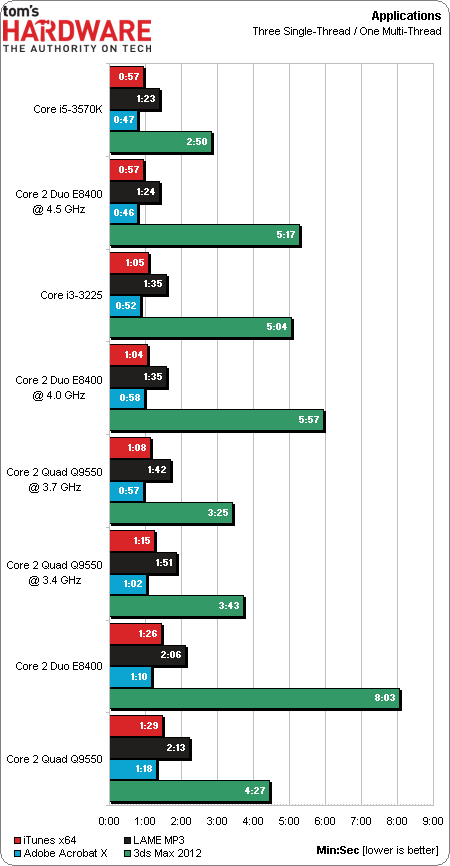Is This Even Fair? Budget Ivy Bridge Takes On Core 2 Duo And Quad
Reader requests affect much of the work we do, and we constantly receive email asking for this one: compare Intel's older Wolfdale- and Yorkfield-based designs against today's budget-friendly Ivy Bridge-based processors. Well, you asked, and we deliver.
Overclocking: More Voltage, Higher Clocks
Cranking Things Up a Notch
We curbed the limits of our Core 2 overclocking to best-represent the maximum frequencies value-seekers with this hardware will probably be using long-term. But the enthusiast in me just couldn’t stop with little or no voltage increase to these E0-stepping chips, knowing I may never again set up this aged platform for testing. Plus, I had already put a considerable amount of tweaking time into this very hardware a few years back, and still had notes handy detailing how high my chips would go, and the voltages required to get there.
At 1.45 V in the BIOS, 1.416 V at idle, or 1.384 V under load, this Core 2 Duo E8400 is stable at 4.5 GHz. It’s seen a fair amount of testing at these settings, but I’d drop voltages and top out in the 4.2-4.3 GHz range for daily use. At this high of a front-side bus frequency, I limited tweaking to CPU clock speed, and didn’t maximize the RAM configuration, running DDR2-1000 @ 5-5-5-15 timings. The Common Performance Level was left at default tRD 09. My success in RAM tweaking on this platform has come with 1 GB sticks of CAS 4 DDR2-800, and with this particular 4 GB kit, voltage requirements have far outweighed any gains.
I don’t like to push Core 2 Quad voltages as high, but would quickly reach the limits of this fairly modest Xigmatek HDT-S1283 air cooler anyway. The Q9550 is stable at 3.7 GHz set to 1.3625 V in the BIOS, resulting in 1.240 V under load. Again for daily use, I’d drop voltage a tad and be in the 3.6-3.65 GHz range, while keeping an eye on temperatures during those hot summer months. This front-side bus results in DDR2-1045 data rates, and with a little bump in voltages, I was able to further tweak the Common Performance Level to tRD 07, boosting memory bandwidth up to 8.36 GB/s.
To be honest, I originally had no intention on publishing this data, and only ran a few applications just for my own fun and knowledge. But the deeper I got into this, the more the information seemed worthy of sharing. Pushed to 4.5 GHz, the Core 2 Duo E8400 is able to match the single-threaded performance of Core i5-3570K at its 3.8 GHz Turbo Boost frequencies. While we know our K-series Core i5 itself has plenty of headroom for higher clock rates, we are still impressed by how well our four-year old E0 stepping Wolfdale-based scales. While the Core 2 Quad's gains are less impressive, we are eager to jump to the next page and see the impact during gaming.
Get Tom's Hardware's best news and in-depth reviews, straight to your inbox.
Current page: Overclocking: More Voltage, Higher Clocks
Prev Page Results: Tomb Raider Next Page Overclocking: 3D Game Performance-
ASHISH65 Wow! this is the review i am waiting from long time.Really good one for budget gamers.Reply -
DarkSable Now this is cool stuff.Reply
Also, amoralman, did you read this? It's basically assuring you that your C2D is still awesome as a budget processor. -
Steelwing Very nice review! I've got a C2D E6600 (2.4 GHz) and had been considering the Core i5-3570K (or possibly wait for a Haswell i5) and was wondering about the performance differences. My CPU is still good for a lot of apps, but I can definitely see a reason to upgrade.Reply -
AMD Radeon pentium dual core G2020 is the minimum i can recommend to budget gamers. i often listed it in sub 450 gaming PCReply -
lpedraja2002 Excellent article, I'm glad I have a more accurate idea on where I stand based on CPU performance, I'm still using my trusty Q6600, G0 @ 3.2ghz. Its good that Tom's still hasn't forgotten that a lot of enthusiast still are rocking Core 2 architecture lol. I think I can manage until Intel releases their next revolutionary CPU.Reply -
assasin32 I been wanting to see one of these for a long time but never thought I get to see it. I just wish they had the good ol e2160, and q6600 thrown into the mix. I have the e2180 OC to 3ghz. It's still chugging along surprisingly enough, I just realized how old the thing was last night after thinking about how long I've had this build and looking up when the main components were produced. Safe to say I got my use out of that $70 cpu, did a 50% OC to it :) and it still had room to go but I wanted to keep the voltage very low.Reply -
jrharbort I've always been curious about how well my own Core 2 Duo P8800 (45nm & 2.66GHz) would stand up against modern ivy bridge offerings. And even though I'm talking about he mobile space, I'm guessing the gains would be comparable to those seen by their desktop counterparts. Each day I'm reminded more and more that I seriously need to move on to a newer system, especially since I work with a lot of media production software. Thanks for the article, it provided some interesting and useful insight.Reply -
smeezekitty Kind of interesting that the old Core 2s beat the I5 in tombrader with TressFX on.Reply
Also holy crap on 1.45 vcore on the C2D -
Proximon I would not have predicted this. Not to this extent. I hope we can make these broader comparisons across years more frequently after this. I predict this will be a very popular article.Reply


